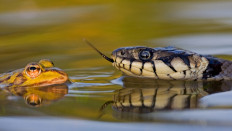
Groups of Organisms
Organisms assessed in Germany’s national Red Lists can be grouped into four informal, overarching categories: (1) vertebrates; (2) invertebrates; (3) plants; (4) fungi and lichens. As part of these main categories, Red Lists were or are being developed for more than 60 different groups of organisms to date by a large number of experts.

Amphibians are among the most important prey items of the European grass snake (Natrix natrix).
Photo: Heinz Buls
Invertebrates account for the majority of Red Lists – 49 so far, including bees, locusts and earthworms – followed by plants with 7 groups: ferns and flowering plants; mosses; several groups of algae. Vertebrates are covered by six, fungi and lichens by three Red Lists, respectively.
The website of the German Red List Centre makes a separate species list available for each of the assessed groups of organisms. These lists not only provide information on the species that occur in Germany, they also provide the threat status.
 Print
Print
